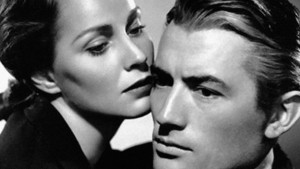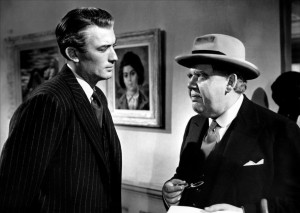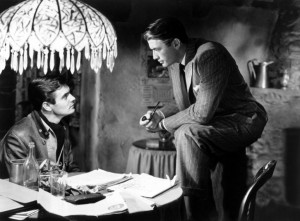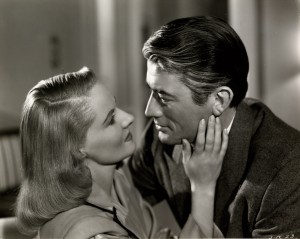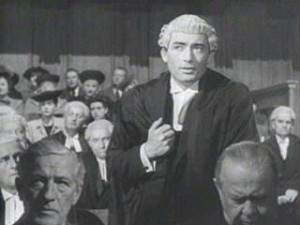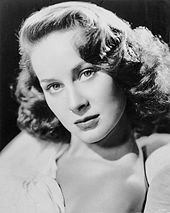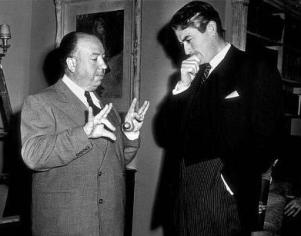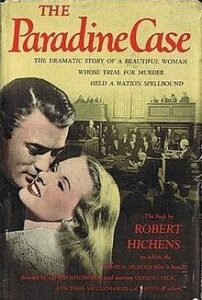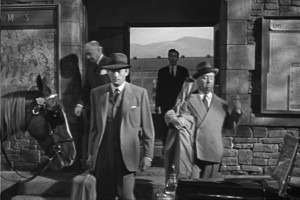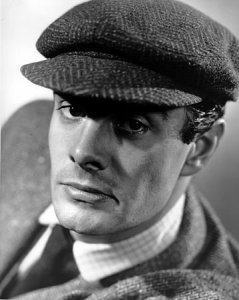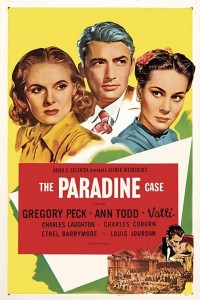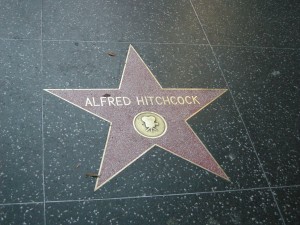The Paradine Case **** (1947, Gregory Peck, Ann Todd, Charles Laughton, Alida Valli, Louis Jourdan, Charles Coburn, Ethel Barrymore) – Classic Movie Review 442
Based on the 1933 novel by Robert Smythe Hichens, Alfred Hitchcock’s 1947 American film The Paradine Case is a twisty, talky and stagey but oddly compelling courtroom thriller, with an excellent cast of stars in Gregory Peck, Ann Todd, Alida Valli, Charles Laughton, Charles Coburn, Ethel Barrymore, and Louis Jourdan. Hitchcock described it as ‘a love story embedded in the emotional quicksand of a murder trial’.
The interfering producer David O Selznick is the main writer of the rather laborious screenplay that focuses on a hot-headed London lawyer Anthony Keane (Gregory Peck), a brilliant barrister defending Mrs Maddalena Anna Paradine (Alida Valli), an enigmatic ice-cool Italian beauty accused of the murder by poisoning of her older, blind husband. Though Keane is married to Gay Keane (Ann Todd), he begins to fall in love with Mrs Paradine and she encourages him.
And, although Keane tells his perceptive and understanding wife that he is willing to quit the case, Gay urges him to continue because a guilty verdict followed by Mrs Paradine’s hanging would destroy their relationship.
The movie magician Hitchcock and his hand-picked ensemble of peerless actors turn the near-sow’s ear of a script into a near-silk pulse of a film, and transform The Paradine Case into something that is engrossing and even fascinating.
As so often with Hitchcock, The Paradine Case has improved with age. It now seems packed with intrigue, tension and mystery typical of Hitchcock. And it may only slightly disappoint those who are looking for sly humour and nail-biting thrills, for it offers neither.
Peck and Valli are excellent as the leads, but Charles Laughton, the star of Hitchcock’s 1938 Jamaica Inn, effortlessly steals the show as the trial judge, Lord Thomas Horfield. ‘Remarkable how the convolutions of a walnut resemble those of the human brain,’ he says, turning the modest line into a winner. And this one too: ‘ I do not like to be interrupted in the middle of an insult.’
There are three other especially pleasurable performances, from Charles Coburn as Mrs Paradine’s solicitor, Sir Simon Flaquer who hires Keane to defend her in court, Leo G Carroll as counsel for the prosecution Sir Joseph and Ethel Barrymore as Lady Sophie Horfield.
Louis Jourdan, John Williams and Joan Tetzel are also essential components of the cast, which also includes John Goldsworthy, Lester Matthews, Pat Aherne, Colin Hunter, Isobel Elsom, Edgar Norton, Elspeth Dudgeon and Colin Keith-Johnston.
Lee Garmes’s black and white cinematography and Franz Waxman’s score provide the veneer of polish The Paradine Case needs to shine. The screenplay is by David O Selznick, Alma Reville (adaptation), James Bridie (adaptation) and Ben Hecht (uncredited). The set designs are by J McMillan Johnson.
The Scottish playwright James Bridie (3 January 1888 in Glasgow – 29 January 1951 in Edinburgh) worked with Hitchcock on The Paradine Case, Under Capricorn (1949) and Stage Fright (1950).
Bridie originally wrote the screenplay on The Paradine Case, and an uncredited Ben Hecht contributed some additional dialogue. But, because of casting, the characters had to be changed, so David O Selznick wrote another script.
MGM submitted drafts of the script to the censors at the Hays Office, who were responsible for changes to the character and fate of Mrs Paradine and also to the portrayal of the judge being as a sadist who relished the death sentence, damaging the script’s impact and integrity.
Both Valli and Jourdan are making their American film debuts.
Selznick bought the rights to Hichens’s novel in 1933 before it was published with Greta Garbo in mind to star, as Garbo was Hichens’s inspiration for the Mrs Paradine character. Garbo considered doing the film, but turned it down, as she decided to retire from acting. She also turned down I Remember Mama and is reputed to have said: ‘No murderesses, no mamas’.
Hichens was gay and he never married. Hichens’s first novel, The Coastguard’s Secret (1886), was written when he was only 17. He first became known with The Green Carnation (1894), though it was published anonymously, a satire of his friends Oscar Wilde and Lord Alfred Douglas. Tragically, the novel made clear Wilde was homosexual and it was withdrawn in 1895 but not before helping set the stage for Wilde’s downfall.
The film was in production from 19 December 1946 to 7 May 1947, with extensive retakes in November 1947. Apart from external shots in the Lake District in Cumbria, the footage was shot on three extravagant sets at Selznick’s lot at Culver City, California. Astoundingly the film cost an estimated $4,258,000, almost as expensive as Selznick’s Gone with the Wind. The lavish set for the courtroom scenes exactly duplicated a courtroom in London’s Old Bailey, built in 85 days at a cost of $80,000. Unusually, the set had ceilings to allow for low camera angles.
Not surprisingly, with these costs (budget $4,258,000), it lost money and worldwide receipts ($2.1 million) barely covered half of the cost of production.
Hitchcock used a new technique for the bravura courtroom sequence, using four cameras shooting simultaneously, each focused on one of the principal actors in the scene. This set-up, including elaborately arranged crane shots, allowed Hitchcock to shoot in long 10-minute takes.
Hitchcock’s rough cut ran almost three hours, and when he insisted on his contractual $1000 a day fee, Selznick took over post-production, supervising the editing and scoring, and went through 18 title changes before renaming it The Paradine Case, the title of the novel, just hours before its world premiere in Los Angeles on 29 December 1947. The jitters with the title are understandable, and the final one lacks class.
On its initial release, the film was 132 minutes long, but after the film’s premieres, Selznick pulled the film from distribution and re-cut it for general release, bringing it down to 114 minutes, the length of the film on DVD release. In 1980, a flood reportedly destroyed the uncut original version of the film, making a restoration of that version unlikely.
The main cast are Gregory Peck as counsel for the defence Anthony Keane, Ann Todd as Gay Keane, Alida Valli as Mrs Maddalena Anna Paradine, Charles Laughton as Judge Lord Thomas Horfield, Charles Coburn as solicitor for the defence Sir Simon Flaquer, Joan Tetzel as Simon Flaquer’s daughter Judy Flaquer, Ethel Barrymore as Lady Sophie Horfield, Louis Jourdan as Col Paradine’s valet André Latour, Leo G Carroll as counsel for the prosecution Sir Joseph, Isobel Elsom as Innkeeper and John Williams as Barrister Collins.
Hitchcock’s cameo appearance this time is as the man carrying a cello case leaving the Cumberland railway station, around 38 minutes into the film.
Louis Jourdan, the debonair French leading man who was brought to Hollywood by producer Selznick to appear in The Paradine Case, died on February 14 2015, aged 93. He famously romanced Leslie Caron in Gigi and played a wealthy Afghan prince in the 1983 James Bond film Octopussy.
© Derek Winnert 2013 Classic Movie Review 442 derekwinnert.com

